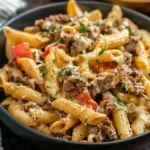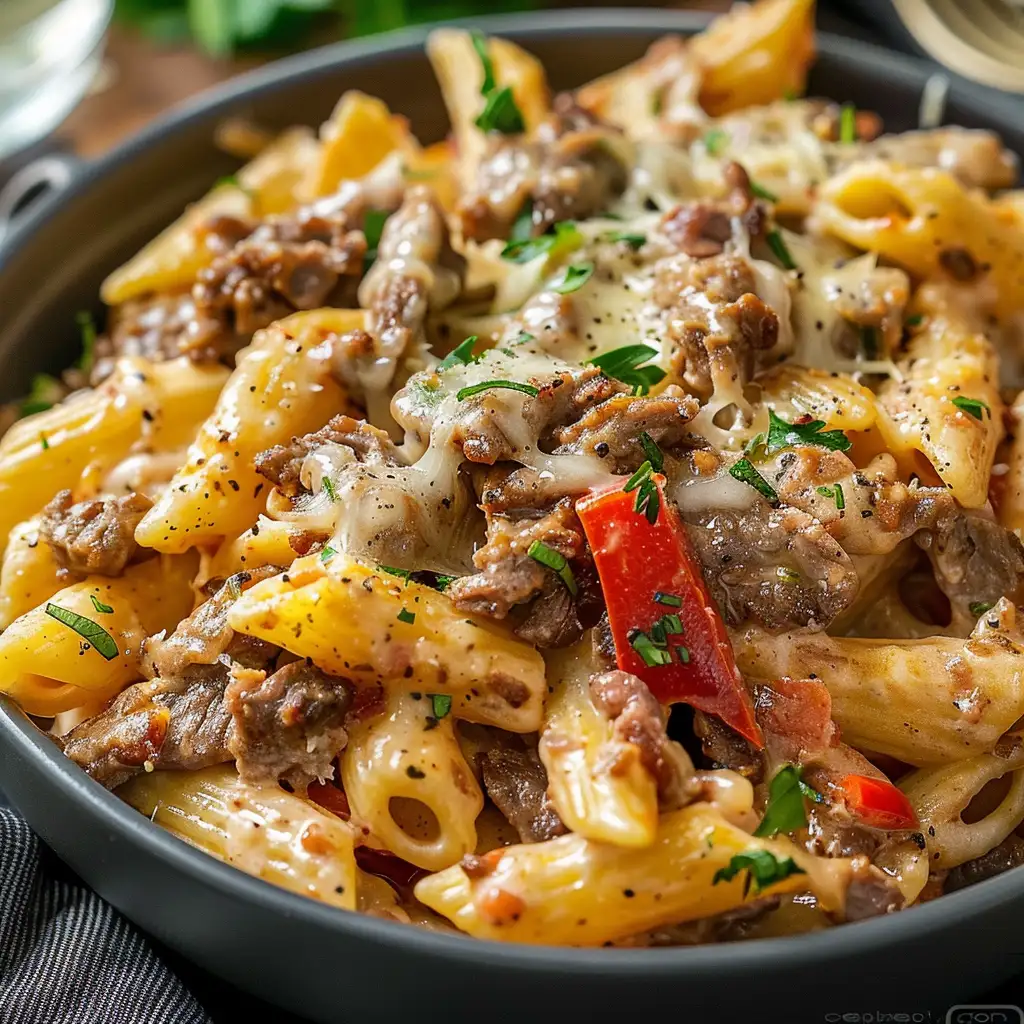The Ultimate Guide to Making Philly Cheesesteak Pasta
Philly Cheesesteak Pasta combines the rich, savory flavors of a classic Philly cheesesteak with the hearty comfort of pasta. Originating from the desire to blend two beloved dishes, this meal has rapidly gained popularity for its delicious taste and ease of preparation. In this article, we’ll explore the essentials of creating your own Philly Cheesesteak Pasta, ensuring a dish that will become a family favorite.
Understanding the Ingredients
The selection of ingredients plays a pivotal role in bringing the flavors of Philly Cheesesteak Pasta to life. Each component, from the meat to the pasta, contributes to the dish’s overall taste and texture.
- Essential Ingredients Overview
- The foundation of this dish includes lean ground beef, Rotini pasta, Campbell’s French Onion Soup, mozzarella, cream cheese, and a mix of vegetables. Together, these ingredients create a melody of flavors that define the essence of Philly Cheesesteak Pasta.
- Deep Dive into Main Ingredients
- Ground Beef: Opting for a lean cut like 90/10 minimizes the need for draining after cooking and ensures a healthier dish. The beef’s robust flavor is crucial to mimicking the taste of a traditional cheesesteak.
- Pasta: Rotini, with its spiral shape, excellently captures the sauce and seasonings, ensuring every bite is as flavorful as the last. For alternatives, consider penne or fusilli.
- Cheeses: The combination of cream cheese and mozzarella provides a creamy, velvety texture that blends seamlessly with the other ingredients, adding a layer of richness to the dish.
- Vegetables and Seasonings
- Finely diced yellow onion, green pepper, and mushrooms not only add a crunch but also build on the complexity of flavors. The inclusion of French Onion Soup elevates the umami, while Worcestershire sauce and spices like paprika, onion powder, and garlic powder round out the taste profile, ensuring each forkful is packed with flavor.
Crafting Philly Cheesesteak Pasta is more than just mixing ingredients; it’s about creating a meal that brings comfort and satisfaction to the dinner table. Whether it’s a weeknight dinner or a special occasion, this dish promises to deliver both taste and texture that’ll have everyone asking for seconds. For a deeper understanding of pasta’s role in this dish, consider exploring Cooking Classy, which offers insights into mastering pasta dishes. Additionally, selecting the right beef is crucial for the perfect cheesesteak experience; guidance can be found through Beef It’s What’s For Dinner.
By focusing on these key elements and following the guidelines provided, you’re well on your way to creating a Philly Cheesesteak Pasta that’s not only delicious but also brimming with the comforting essence of both dishes it draws inspiration from.
Cooking Process Explained
Crafting the perfect Philly Cheesesteak Pasta involves a careful blend of ingredients, precise cooking techniques, and a dash of culinary creativity. Let’s dive into the preparation steps and cooking tips to ensure your dish is both delicious and satisfying.
Preparation Steps
To begin, ensure you have all your ingredients ready. The cooking process is swift, and having everything at hand makes it smoother.
- Sauté the Veggies: In a large skillet, melt butter over medium heat. Add finely diced onions, green peppers, and mushrooms. Cook until they are soft and slightly caramelized, about 10-15 minutes. This foundational step is crucial for building flavor.
- Brown the Beef: Increase the heat to medium-high and add the lean ground beef to the skillet. Use a ground meat chopper to break the meat into small, uniform pieces as it cooks. This ensures that every bite is infused with the seasoning and vegetable mix.
- Season: Once the beef is fully cooked and no longer pink, sprinkle in garlic powder, onion powder, paprika, and a dash of black pepper. The seasoning should be well-distributed throughout the meat and veggie mixture.
- Add Soup and Cream Cheese: Stir in the French Onion Soup and bring the mixture to a simmer. Cube the cream cheese and add it to the skillet, stirring until it’s completely melted and incorporated into the sauce.
- Combine with Pasta: Lastly, fold in the cooked Rotini pasta, ensuring each noodle is evenly coated with the creamy, flavorful sauce. Add shredded mozzarella and mix well until the cheese is melted and the pasta is beautifully cheesy.
Cooking Techniques and Tips
- Ground Meat Chopper: This handy tool is not just for breaking up beef; it’s excellent for mixing ingredients in the skillet, ensuring even cooking and flavor distribution. Its use here is integral to achieving the perfect texture for the Philly Cheesesteak Pasta.
- Flavor Adjustment: Before adding the pasta, taste the beef and veggie mixture. Adjust the seasonings if needed. The key to a flavorful dish is balancing the savory notes of the beef with the creaminess of the cheeses.
- Simmering: Once the French Onion Soup is added, allow the mixture to simmer for a few minutes. This concentrates the flavors, creating a deeper and more cohesive sauce.
- Cheese Melting Technique: When adding mozzarella, turn off the heat to avoid overcooking the cheese. This ensures it melts perfectly, giving the dish a luxuriously creamy texture without becoming oily or separated.
By following these steps and tips, you’ll craft a Philly Cheesesteak Pasta that’s not only hearty and filling but also brimming with complex flavors that pay homage to the classic Philly Cheesesteak. For additional guidance on perfecting pasta dishes, explore insights from Serious Eats on achieving creamy and delightful pasta creations.
Serving and Enjoyment
Bringing Philly Cheesesteak Pasta to the table is more than just about serving a meal; it’s about creating an experience that’s visually appealing and immensely satisfying. Here are some final touches and tips for serving:
- Cheese Melting Perfection: To achieve a beautifully creamy texture, add the mozzarella cheese off the heat, allowing it to gently melt through the residual warmth of the pasta. This method ensures the cheese integrates smoothly without becoming rubbery or oily.
- Presentation Tips: Serve the pasta in a pre-warmed dish to maintain its temperature. Garnish with a sprinkle of dried parsley or fresh green onions for a pop of color and freshness. For an elegant touch, accompany the dish with a side of garlic bread or a simple green salad.
For those looking to enhance their culinary skills, especially in presenting and serving dishes, explore additional insights and tips at Food Network’s guide to plating like a pro.
FAQs
Handling Leftovers
- Leftovers of Philly Cheesesteak Pasta can be stored in an airtight container in the refrigerator for up to three days. For reheating, gently warm it on the stove over medium heat, adding a splash of milk or water to loosen the sauce.
Substituting Ingredients
- Dietary Restrictions: For a gluten-free version, use gluten-free pasta. Dairy-free cheeses can replace traditional cheeses for those with lactose intolerance.
- Meat Alternatives: Vegetarians can opt for plant-based ground meat or sautéed mushrooms as a hearty substitute for beef.
To explore more about substituting ingredients without compromising on taste, Epicurious provides a comprehensive guide on ingredient swaps.
Making the Dish Healthier
- Reduce Calories: Swap out regular cream cheese for a light version and opt for skim mozzarella to cut down on fat without losing the creamy texture and flavor.
- Lean Meats: Using extra-lean ground beef or even ground turkey can make the dish lighter while still being satisfying.
For those interested in making healthier meal choices without sacrificing flavor, the American Heart Association offers valuable tips on healthy cooking techniques that can be applied to a variety of dishes, including this one.
By focusing on these key aspects of serving, storing, and adapting the Philly Cheesesteak Pasta, you can ensure a delightful meal that caters to various tastes and dietary needs. Remember, the essence of a great dish lies not only in its flavors but also in how it’s presented and shared.
Print
- Total Time: 30 minutes
- Yield: Serves 4
Description
This Philly Cheesesteak Pasta is a delectable twist on the classic sandwich. Combining seasoned beef, tender macaroni, and a rich, creamy sauce, it’s a comforting dish guaranteed to satisfy the whole family.
Ingredients
- 2 tablespoons olive oil
- 1 pound ground beef
- ½ yellow or sweet onion, diced
- Salt and pepper to taste
- 2 teaspoons Worcestershire sauce
- 1 green bell pepper, diced
- 8 ounces elbow macaroni, uncooked
- 1 cup water
- 14.5 ounce can beef broth
- ½ cup 2% milk
- 2 ounces cream cheese, cubed
- ½ cup mozzarella cheese, shredded
- 6 to 8 ounces provolone cheese, sliced
- Fresh parsley, chopped, for garnish
Instructions
- Heat olive oil in a skillet over medium heat. Brown the beef and onion. Season with salt and pepper.
- Add Worcestershire sauce, bell pepper, uncooked pasta, water, and beef broth. Bring to a boil, then simmer covered for 15 minutes.
- Add milk and cream cheese over low heat until incorporated.
- Off heat, mix in mozzarella and half the provolone until melted.
- Top with remaining provolone, cover to melt, then garnish with parsley.
Notes
- Substitute Worcestershire sauce with a homemade mix of soy sauce, lemon juice, sugar, and hot sauce if needed.
- Provolone can be replaced with additional mozzarella for extra cheesiness.
- Consider adding fried onions on top for an added crunch.
- Prep Time: 10 minutes
- Cook Time: 20 minutes
- Category: Dinner
- Method: Sauté and Simmer
- Cuisine: American
Nutrition
- Serving Size: per serving
- Calories: 836
- Sugar: 5g
- Sodium: 1015mg
- Fat: 51g
- Saturated Fat: 22g
- Carbohydrates: 49g
- Fiber: 3g
- Protein: 44g
- Cholesterol: 139mg




